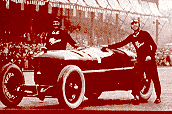Sorry for the lack of image.... Finally got it sorted, posted it below as reply...
I happen to be restoring a 1937 Rudge 500 Special, others afflicted with this strange hobby send me stuff...
The below was accomplished on Montlhery track, 20 kms outside of Paris with piloting duties split between the Lieut-Col. and his "Mrs.".... they set a new world record
in March 1925 !!!!

"Engineer Raymond JAMIN was hired to design the track . It is oval with two short straight lines of 180 meters. In the turns, it has a concave profile in the shape of a cubic parabola with a vertical axis and connections are traced according to a spiral logarithmic curve, which constitutes one of the characteristics of the design. The ring is calculated so that cars of 1 000 kg can reach, in the top of the turns, speeds of approximately 220 km/h. Its development, measured in the middle of its projection on a horizontal level is 2 548.24 metres (centre line). Two thousand workmen, masons, metal workers, scrap merchants, carpenters and truckdrivers worked for six months on the construction of the track, using 1 000 tons of steel and 8 000 m3 of concrete. Many ready-made units were used, making it an avant-garde construction for that time.
Montlhéry soon attracted a great number of pioneers of speed and their monstrous record cars, coming over from England because of the many noise restrictions (assembly of silencers, prohibition of races at night) imposed by the neighbours of the Brooklands circuit. Over one hundred records, were established or beaten justtwo months after the opening. It was the make Rolland Pilain which was the first to do so, and the solo circuit record on the ring was to be held for a long time by Gwenda Stewart in a Derby-Miller with an average of 234,681 km/h.
Linas-Montlhéry was also a place where races were organized. The Automobile Club de France Grand Prix was held for the first time in 1925, after the addition of a road circuit built in record time (the complete circuit totals 12.500 kms). It attracted a considerable crowd including the President of the Republic himself.
 The cars went clockwise whereas the records were carried out in the opposite direction. Unfortunately, during the race, Antonio Ascari died while driving his Alfa Romeo P2 on the new portion of the circuit. Eventually, it was Robert Benoist in his Delage 12 cylinders who won. The ACF GP was held from 1931 to 1937 (except 1932) according to various formulas which always attracted many spectators, coming to attend the duels between Alfa Romeo and Bugatti and then, on the arrival of the Auto-union, Mercedes and Delage.
The cars went clockwise whereas the records were carried out in the opposite direction. Unfortunately, during the race, Antonio Ascari died while driving his Alfa Romeo P2 on the new portion of the circuit. Eventually, it was Robert Benoist in his Delage 12 cylinders who won. The ACF GP was held from 1931 to 1937 (except 1932) according to various formulas which always attracted many spectators, coming to attend the duels between Alfa Romeo and Bugatti and then, on the arrival of the Auto-union, Mercedes and Delage.
The sanctioning body was FICM. Fédération Internationale des Clubs Motocyclistes (FICM),
more commonly known today as FIM.

I happen to be restoring a 1937 Rudge 500 Special, others afflicted with this strange hobby send me stuff...
The below was accomplished on Montlhery track, 20 kms outside of Paris with piloting duties split between the Lieut-Col. and his "Mrs.".... they set a new world record
in March 1925 !!!!
"Engineer Raymond JAMIN was hired to design the track . It is oval with two short straight lines of 180 meters. In the turns, it has a concave profile in the shape of a cubic parabola with a vertical axis and connections are traced according to a spiral logarithmic curve, which constitutes one of the characteristics of the design. The ring is calculated so that cars of 1 000 kg can reach, in the top of the turns, speeds of approximately 220 km/h. Its development, measured in the middle of its projection on a horizontal level is 2 548.24 metres (centre line). Two thousand workmen, masons, metal workers, scrap merchants, carpenters and truckdrivers worked for six months on the construction of the track, using 1 000 tons of steel and 8 000 m3 of concrete. Many ready-made units were used, making it an avant-garde construction for that time.
Montlhéry soon attracted a great number of pioneers of speed and their monstrous record cars, coming over from England because of the many noise restrictions (assembly of silencers, prohibition of races at night) imposed by the neighbours of the Brooklands circuit. Over one hundred records, were established or beaten justtwo months after the opening. It was the make Rolland Pilain which was the first to do so, and the solo circuit record on the ring was to be held for a long time by Gwenda Stewart in a Derby-Miller with an average of 234,681 km/h.
Linas-Montlhéry was also a place where races were organized. The Automobile Club de France Grand Prix was held for the first time in 1925, after the addition of a road circuit built in record time (the complete circuit totals 12.500 kms). It attracted a considerable crowd including the President of the Republic himself.

The sanctioning body was FICM. Fédération Internationale des Clubs Motocyclistes (FICM),
more commonly known today as FIM.
Last edited:

